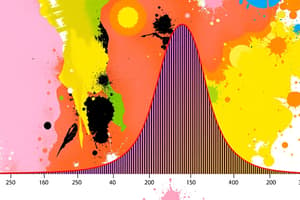Podcast
Questions and Answers
In a normal distribution, approximately what percentage of data falls within two standard deviations of the mean?
In a normal distribution, approximately what percentage of data falls within two standard deviations of the mean?
95%
Explain how the Z-score is used to determine if a data point is above or below the mean.
Explain how the Z-score is used to determine if a data point is above or below the mean.
A positive Z-score indicates the data point is above the mean, while a negative Z-score indicates it is below the mean.
If a dataset has a mean of 50 and a standard deviation of 10, what is the Z-score for a data point of 70?
If a dataset has a mean of 50 and a standard deviation of 10, what is the Z-score for a data point of 70?
2
How can you determine the probability of a value being less than a given data point using the Z-table?
How can you determine the probability of a value being less than a given data point using the Z-table?
Describe one practical application of normal distribution in finance.
Describe one practical application of normal distribution in finance.
What does a Z-score of 0 indicate about a data point relative to the mean?
What does a Z-score of 0 indicate about a data point relative to the mean?
Explain how the standard deviation affects the shape of a normal distribution curve.
Explain how the standard deviation affects the shape of a normal distribution curve.
In quality control, how might normal distribution be used to monitor a manufacturing process?
In quality control, how might normal distribution be used to monitor a manufacturing process?
If the area to the left of a Z-score is 0.8413, what does this imply about the percentage of data below that Z-score?
If the area to the left of a Z-score is 0.8413, what does this imply about the percentage of data below that Z-score?
A student scores 80 on a test where the mean is 70 and the standard deviation is 5. What is the student's Z-score, and what does it indicate?
A student scores 80 on a test where the mean is 70 and the standard deviation is 5. What is the student's Z-score, and what does it indicate?
How does the symmetry of the normal distribution simplify statistical calculations?
How does the symmetry of the normal distribution simplify statistical calculations?
If a Z-score is -1.5, explain what this means in terms of the data point's relationship to the mean and standard deviation.
If a Z-score is -1.5, explain what this means in terms of the data point's relationship to the mean and standard deviation.
Describe how the Empirical Rule can quickly estimate data distribution in a normal distribution without using a Z-table.
Describe how the Empirical Rule can quickly estimate data distribution in a normal distribution without using a Z-table.
In psychology, how is the normal distribution used to interpret scores on standardized tests like IQ tests?
In psychology, how is the normal distribution used to interpret scores on standardized tests like IQ tests?
Explain the significance of the Z-table in hypothesis testing.
Explain the significance of the Z-table in hypothesis testing.
How would increasing the sample size typically affect the normal distribution of sample means (Central Limit Theorem)?
How would increasing the sample size typically affect the normal distribution of sample means (Central Limit Theorem)?
If you know a Z-score, how can you find the area to the right of that Z-score using the Z-table?
If you know a Z-score, how can you find the area to the right of that Z-score using the Z-table?
What are the main assumptions required for a dataset to reasonably follow a normal distribution?
What are the main assumptions required for a dataset to reasonably follow a normal distribution?
Describe a scenario where using the normal distribution might not be appropriate for modeling data.
Describe a scenario where using the normal distribution might not be appropriate for modeling data.
A data set has a mean of 100 and a standard deviation of 15. What range captures approximately 99.7% of the data, assuming a normal distribution?
A data set has a mean of 100 and a standard deviation of 15. What range captures approximately 99.7% of the data, assuming a normal distribution?
Flashcards
Normal Distribution
Normal Distribution
A continuous probability distribution symmetric around the mean, often depicted as a bell-shaped curve.
Mean (μ)
Mean (μ)
The average of all data points in a normal distribution.
Standard Deviation (σ)
Standard Deviation (σ)
A measure of how spread out the data points are around the mean in a normal distribution.
68% Rule
68% Rule
Signup and view all the flashcards
95% Rule
95% Rule
Signup and view all the flashcards
99.7% Rule
99.7% Rule
Signup and view all the flashcards
Z-score
Z-score
Signup and view all the flashcards
Z-score Formula
Z-score Formula
Signup and view all the flashcards
Z = 0
Z = 0
Signup and view all the flashcards
Z > 0
Z > 0
Signup and view all the flashcards
Z < 0
Z < 0
Signup and view all the flashcards
Z-Table
Z-Table
Signup and view all the flashcards
Psychology Application
Psychology Application
Signup and view all the flashcards
Finance Application
Finance Application
Signup and view all the flashcards
Quality Control Application
Quality Control Application
Signup and view all the flashcards
Study Notes
- Normal distribution is a continuous probability distribution
- It is symmetric around the mean and shaped like a bell curve
Key Features of Normal Distribution
- Display symmetry, where one side mirrors the other
- Mean (μ) represents the average of all data points
- Standard Deviation (σ) measures the spread of data points around the mean
Empirical Rule
- Approximately 68% of data is within 1 standard deviation (σ) of the mean (μ)
- Approximately 95% of data is within 2 standard deviations (2σ)
- Approximately 99.7% of data is within 3 standard deviations (3σ)
Z-Scores
- A Z-score indicates how many standard deviations a data point (X) is from the mean (μ)
- Z-score formula: ( Z = \frac{(X - \mu)}{\sigma} )
- Z is the Z-score
- X is the value of the data point
- μ is the mean of the distribution
- σ is the standard deviation of the distribution
Interpretation of Z-Scores
- Z = 0: Value is exactly at the mean
- Z > 0: Value is above the mean
- Z < 0: Value is below the mean
Example Z-Score Calculation
- Dataset has a mean (μ) = 100
- Standard Deviation (σ) = 15
- A data point (X) = 130
- Calculation: ( Z = \frac{(130 - 100)}{15} = \frac{30}{15} = 2 )
- The data point 130 is 2 standard deviations above the mean
Z-Table
- A Z-table provides the area (probability) to the left of a given Z-score in a standard normal distribution
- The area from the Z-table represents the probability of a value being less than or equal to the Z-score
How to Use a Z-Table
- Calculate the Z-score using the formula
- Look up the Z-score in the Z-table to find the corresponding probability
Example of Z-Table Usage
- A Z-score of 2.00 corresponds to a value of 0.9772 in the Z-table
- Approximately 97.72% of the data falls below a Z-score of 2.00
Application of Normal Distribution
- Used when analyzing test scores, like IQ tests
- Used in modeling stock returns and risk assessment
- Used in monitoring manufacturing processes for quality control
Key Formulas
- Z-Score Formula: ( Z = \frac{(X - \mu)}{\sigma} )
- Empirical Rule:
- 68% of data is within ( \mu \pm 1\sigma )
- 95% of data is within ( \mu \pm 2\sigma )
- 99.7% of data is within ( \mu \pm 3\sigma )
Studying That Suits You
Use AI to generate personalized quizzes and flashcards to suit your learning preferences.




